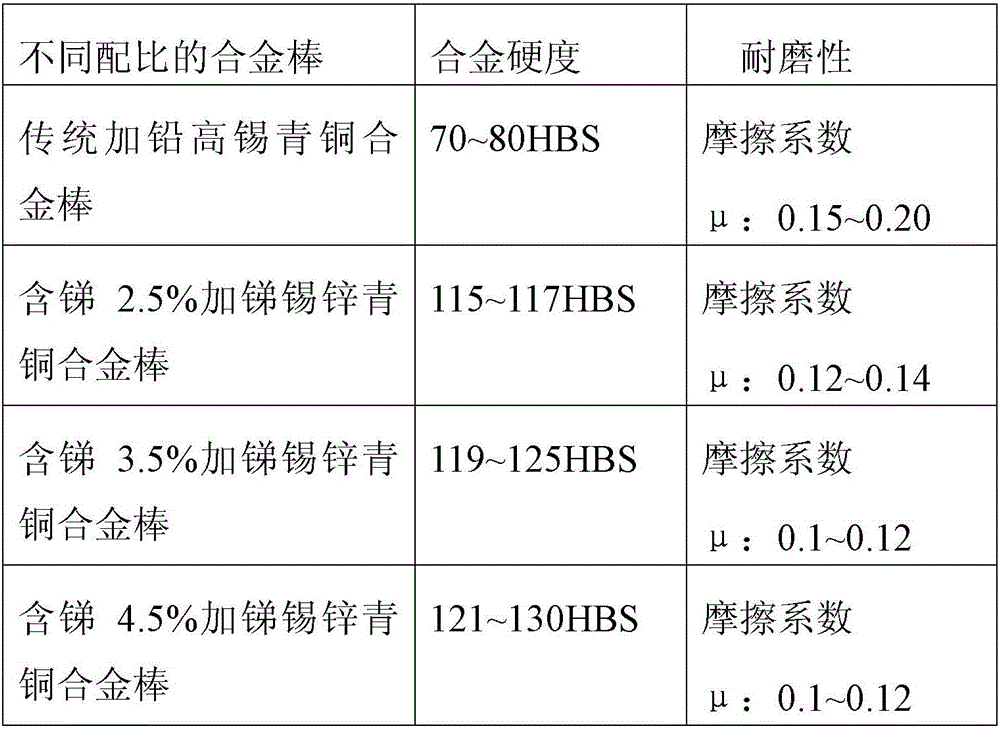Antimony-tin-zinc-bronze alloy bar for high speed railway equipment and preparing method of antimony-tin-zinc-bronze alloy bar
A high-speed railway, bronze alloy technology, applied in the field of alloy materials, can solve the problems of human body and environmental impact, can not meet the requirements, lead-containing elements are toxic, etc., and achieve the effects of improving environmental protection performance, preventing oxidation, and improving wear resistance.
- Summary
- Abstract
- Description
- Claims
- Application Information
AI Technical Summary
Problems solved by technology
Method used
Image
Examples
Embodiment 1
[0029] A preparation method for an antimony-tin-zinc bronze alloy rod for high-speed railway equipment, comprising the steps of:
[0030] 1) According to the mass percentage of 2.5% antimony, 6% tin, 3% zinc, and 82.5% electrolytic copper, configure the raw materials, place them in a power frequency electric furnace, heat them to 1250-1300 degrees, and keep them warm to 1250 degrees after they are completely melted. Spend;
[0031] 2) The above-mentioned completely melted alloy liquid is fully stirred with a special graphite tool, and then the well-stirred alloy liquid is covered with high-purity scaly graphite powder to prevent its oxidation. The thickness of the graphite powder is about 10- 15mm;
[0032] 3) After 25-30 minutes of heat preservation, reheat to 1300 degrees, and turn on the vibration device of the power frequency electric furnace, the vibration frequency is 1 time / second, and the outer diameter is 45 mm and the length is 2000 mm. solid alloy bars;
[0033] ...
Embodiment 2
[0041] Embodiment 2 is different from Embodiment 1 only in the ratio of raw materials, and is the same in other respects. Therefore, only the differences will be described below.
[0042] This embodiment 2 is different from embodiment 1 only in that: in step 1) according to the mass percentage of antimony 3.0%, tin 7%, zinc 4.5%, electrolytic copper 84.5%, configure raw material, and it is placed in power frequency electric furnace Inside.
[0043] The alloy hardness of the antimony-added tin-zinc bronze alloy rod in this embodiment can be greatly increased to 119-125HBS (Brinell hardness), and as the antimony content increases, its friction decreases to 0.1-0.12, indicating its wear resistance There is also a corresponding increase.
Embodiment 3
[0045] Embodiment 3 is different from embodiment 2 only in the ratio of raw materials, and is the same in other respects. Therefore, only the differences will be described below.
[0046] The present embodiment 3 is different from embodiment 2 only in that: in step 1) according to the mass percentage of antimony 4.5%, tin 6.1%, zinc 5.4%, electrolytic copper 83%, configure raw material, and it is placed in power frequency electric furnace Inside.
[0047] The alloy hardness of the antimony-added tin-zinc bronze alloy rod in this embodiment can be greatly increased to 121-130HBS (Brinell hardness), and as the antimony content increases, its friction decreases to 0.1-0.12, indicating its wear resistance There is also a corresponding increase.
[0048] Table 1
[0049]
[0050] Based on above-mentioned embodiment, as shown in table 1, the alloy hardness of traditional leaded high-tin bronze alloy rod is 70~80HBS (Brinell hardness), friction coefficient μ is 0.15~0.20, the p...
PUM
| Property | Measurement | Unit |
|---|---|---|
| Length | aaaaa | aaaaa |
| Diameter | aaaaa | aaaaa |
| Hardness | aaaaa | aaaaa |
Abstract
Description
Claims
Application Information
 Login to View More
Login to View More - R&D Engineer
- R&D Manager
- IP Professional
- Industry Leading Data Capabilities
- Powerful AI technology
- Patent DNA Extraction
Browse by: Latest US Patents, China's latest patents, Technical Efficacy Thesaurus, Application Domain, Technology Topic, Popular Technical Reports.
© 2024 PatSnap. All rights reserved.Legal|Privacy policy|Modern Slavery Act Transparency Statement|Sitemap|About US| Contact US: help@patsnap.com








